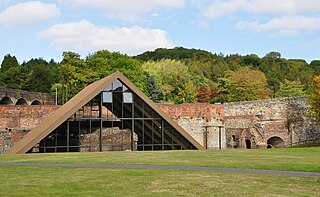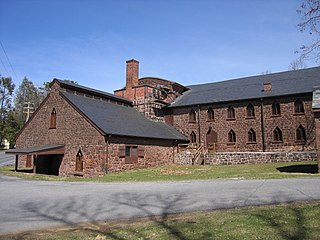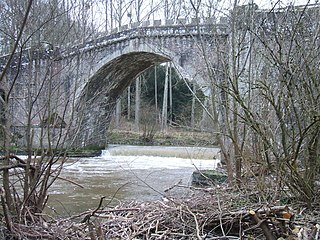
The Lancashire hearth was used to fine pig iron, removing carbon to produce wrought iron.

The Lancashire hearth was used to fine pig iron, removing carbon to produce wrought iron.
Until the early 19th century, the usual method of producing wrought iron involved a charcoal-fired finery in a finery forge. In the beginning of the 19th century this became an obsolete process and was slowly replaced by the coal-fueled puddling process. However, charcoal continued to be used in some forges after most of the iron industry had abandoned it for coke. [1]
In 1813 when John Bradley & Co. (whose leading partner was James Foster) took over forges at Eardington in Shropshire, a potting and stamping forge, they reverted to using charcoal. In 1820, he bought Hampton Loade Forge, which then became a tinplate works and in 1826 another charcoal forge. This was followed by other charcoal forges at Horsehay in 1832 and at the Old Park ironworks of the Botfield family about 1826. Cookley Forge in the Stour valley also reverted to charcoal working in 1814, supplying wire and tinplate mills. [1]
By the 1830s, these forges were sometimes producing over 2000 tons of iron per year, compared with a few hundred from earlier finery forges. It is likely that these forges were using a more efficient variety of hearth, which from Swedish usage has come to be known as a Lancashire hearth. [1]

Faced with competition from cheaper British iron production, the Swedish iron industry needed to find a new cheaper method of making iron. In the 1810s, experiments were made with puddling, but this proved unsatisfactory, as it needed coal of which Sweden had none. After Gustav Ekman visited Britain, he published a report of his observations.[ when? ] He had seen closed finery hearths in south Wales and near Ulverston, then in Lancashire (now Cumbria). Those in south Wales were similar to puddling furnaces, but in Lancashire, he saw closed furnaces, where the metal was in contact with the fuel. On his return to Sweden, Ekman experimented and built furnaces similar to what he had seen near Ulverston, [2] most probably at Newland ironworks.
In 1829-30, Waern installed a furnace of the south Wales type at Backefors ironworks, while independently Ekman built Lancashire hearths at Dormsjö and Söderfors. From there the process spread to other forges. Charcoal consumption by the metallurgical industry in Sweden peaked about 1885. [3] In 1887, 406 hearths made 210,500 tons of iron. The last Lancashire forge in Sweden was at Ramnäs, closed in 1964. [2] [4]
In Shropshire, charcoal iron production continued on a significant scale, but declined after 1870, rods for wire-drawing being a significant product. However most charcoal forges were probably closed by 1890. [1]

The Swedish Lancashire hearth consisted of a rectangular closed furnace with a chimney (8 metres high) at one end and a working arch in front of the hearth proper at the other. Pig iron was charged through a door at the foot of the chimney and stacked on an iron-clad bridge so that it could be heated by the waste gases from the hearth. The hearth was blown through a single water-cooled tuyere with pre-heated air. The hearth consisted of a rectangular box of iron plates, the bottom plate being water-cooled. Surplus slag was removed with a shovel between finings, but some was left to help the process. Pig stacked on the bridge at the back of the hearth was then pulled forward with a hook and charcoal added. The blast was then turned on and fining began. [2]
When the pigs began to melt, rabelling[ check spelling ] began (as in the Walloon process) using two bars of iron one to stir the iron and the other to lift it back into the blast. Periodically the tuyere had to be cleaned of matter adhering to it with a third bar. Finally, the iron was gathered into a 'loop' which was lifted out of the hearth with a heavier bar and tongs, and taken to the shingling hammer. [2]
The process was more fuel-efficient and more productive than its predecessors. [2]

A forge is a type of hearth used for heating metals, or the workplace (smithy) where such a hearth is located. The forge is used by the smith to heat a piece of metal to a temperature at which it becomes easier to shape by forging, or to the point at which work hardening no longer occurs. The metal is transported to and from the forge using tongs, which are also used to hold the workpiece on the smithy's anvil while the smith works it with a hammer. Sometimes, such as when hardening steel or cooling the work so that it may be handled with bare hands, the workpiece is transported to the slack tub, which rapidly cools the workpiece in a large body of water. However, depending on the metal type, it may require an oil quench or a salt brine instead; many metals require more than plain water hardening. The slack tub also provides water to control the fire in the forge.

Pig iron, also known as crude iron, is an intermediate product of the iron industry in the production of steel which is obtained by smelting iron ore in a blast furnace. Pig iron has a high carbon content, typically 3.8–4.7%, along with silica and other constituents of dross, which makes it brittle and not useful directly as a material except for limited applications.

Wrought iron is an iron alloy with a very low carbon content in contrast to that of cast iron. It is a semi-fused mass of iron with fibrous slag inclusions, which give it a wood-like "grain" that is visible when it is etched, rusted, or bent to failure. Wrought iron is tough, malleable, ductile, corrosion resistant, and easily forge welded, but is more difficult to weld electrically.

A blast furnace is a type of metallurgical furnace used for smelting to produce industrial metals, generally pig iron, but also others such as lead or copper. Blast refers to the combustion air being "forced" or supplied above atmospheric pressure.

Coalbrookdale is a village in the Ironbridge Gorge in Shropshire, England, containing a settlement of great significance in the history of iron ore smelting. It lies within the civil parish called the Gorge.

The cementation process is an obsolete technology for making steel by carburization of iron. Unlike modern steelmaking, it increased the amount of carbon in the iron. It was apparently developed before the 17th century. Derwentcote Steel Furnace, built in 1720, is the earliest surviving example of a cementation furnace. Another example in the UK is the cementation furnace in Doncaster Street, Sheffield.

The Wealden iron industry was located in the Weald of south-eastern England. It was formerly an important industry, producing a large proportion of the bar iron made in England in the 16th century and most British cannon until about 1770. Ironmaking in the Weald used ironstone from various clay beds, and was fuelled by charcoal made from trees in the heavily wooded landscape. The industry in the Weald declined when ironmaking began to be fuelled by coke made from coal, which does not occur accessibly in the area.

A reverberatory furnace is a metallurgical or process furnace that isolates the material being processed from contact with the fuel, but not from contact with combustion gases. The term reverberation is used here in a generic sense of rebounding or reflecting, not in the acoustic sense of echoing.

An ironworks or iron works is an industrial plant where iron is smelted and where heavy iron and steel products are made. The term is both singular and plural, i.e. the singular of ironworks is ironworks.

Abraham Darby, in his later life called Abraham Darby the Elder, now sometimes known for convenience as Abraham Darby I, was an English ironmaster and foundryman. Born into an English Quaker family that played an important role in the Industrial Revolution, Darby developed a method of producing pig iron in a blast furnace fuelled by coke rather than charcoal. This was a major step forward in the production of iron as a raw material for the Industrial Revolution.

Puddling is the process of converting pig iron to bar (wrought) iron in a coal fired reverberatory furnace. It was developed in England during the 1780s. The molten pig iron was stirred in a reverberatory furnace, in an oxidizing environment, resulting in wrought iron. It was one of the most important processes of making the first appreciable volumes of valuable and useful bar iron without the use of charcoal. Eventually, the furnace would be used to make small quantities of specialty steels.

A tuyere or tuyère is a tube, nozzle or pipe through which air is blown into a furnace or hearth.

A finery forge is a forge used to produce wrought iron from pig iron by decarburization in a process called "fining" which involved liquifying cast iron in a fining hearth and removing carbon from the molten cast iron through oxidation. Finery forges were used as early as the 3rd century BC in China. The finery forge process was replaced by the puddling process and the roller mill, both developed by Henry Cort in 1783–4, but not becoming widespread until after 1800.
Thomas and George Cranege, who worked in the ironworking industry in England in the 1760s, are notable for introducing a new method of producing wrought iron from pig iron.

Osmond iron was wrought iron made by a particular process. This is associated with the first European production of cast iron in furnaces such as Lapphyttan in Sweden.
The Wilden Ironworks was an ironworks in Wilden, Worcestershire, England. It operated for many years and was acquired by the Baldwin family, ancestors of British Prime Minister Stanley Baldwin.

A Walloon forge is a type of finery forge that decarbonizes pig iron into wrought iron.

Ferrous metallurgy is the metallurgy of iron and its alloys. The earliest surviving prehistoric iron artifacts, from the 4th millennium BC in Egypt, were made from meteoritic iron-nickel. It is not known when or where the smelting of iron from ores began, but by the end of the 2nd millennium BC iron was being produced from iron ores in the region from Greece to India, and Sub-Saharan Africa. The use of wrought iron was known by the 1st millennium BC, and its spread defined the Iron Age. During the medieval period, smiths in Europe found a way of producing wrought iron from cast iron using finery forges. All these processes required charcoal as fuel.

Cornwall Iron Furnace is a designated National Historic Landmark that is administered by the Pennsylvania Historical and Museum Commission in Cornwall, Lebanon County, Pennsylvania in the United States. The furnace was a leading Pennsylvania iron producer from 1742 until it was shut down in 1883. The furnaces, support buildings and surrounding community have been preserved as a historical site and museum, providing a glimpse into Lebanon County's industrial past. The site is the only intact charcoal-burning iron blast furnace in its original plantation in the western hemisphere. Established by Peter Grubb in 1742, Cornwall Furnace was operated during the Revolution by his sons Curtis and Peter Jr. who were major arms providers to George Washington. Robert Coleman acquired Cornwall Furnace after the Revolution and became Pennsylvania's first millionaire. Ownership of the furnace and its surroundings was transferred to the Commonwealth of Pennsylvania in 1932.

Bringewood Ironworks was a charcoal ironworks in north Herefordshire. It was powered by the river Teme, with a blast furnace, a finery forge and latterly a rolling mill for blackplate.